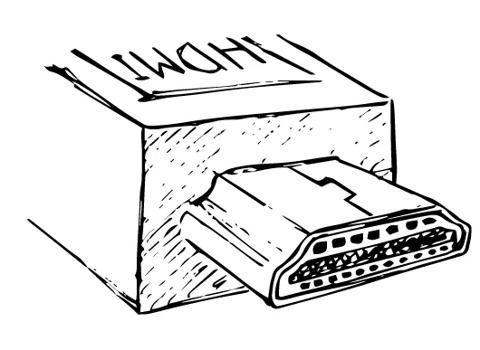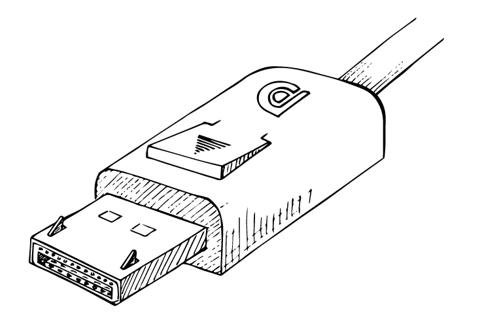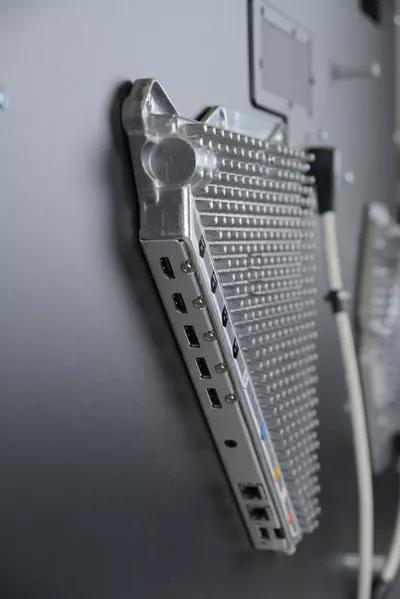Rückseite
20.11.2018
DisplayPort vs HDMI: What is the difference?
DISPLAYS - KÜNFTIGE ÜBERARBEITUNG Lesezeit 6 Min.
DisplayPort and HDMI are two distinct standards for transmitting video and audio from a player to a display. But what is – apart from the clearly distinct connectors – the difference between DisplayPort and HDMI? After all they were designed to do the same thing, right? In this article we try to give you some advice…
There are a lot of examples in technology history of multiple competing standards that were on the market simultaneously. Just think about the video recorder standards war in the early 1980s between Video 2000, VHS and Betamax. For the youngsters amongst us, VHS finally won mainly because of its lower cost and support by the adult movie industry. More recently, there was the battle between Blu-ray and HD DVD.
DisplayPort or HDMI: who is who?
So is there also a format war between DisplayPort and HDMI going on? Not exactly. While both HDMI and DisplayPort have the same objective, they were in fact conceived under different constellations.
HDMI (short for High-Definition Multimedia Interface) was introduced in 2003 by a consortium of (mainly) display manufacturers, including Sony, Philips, Panasonic, and Toshiba. These are large corporations that primarily target purely image driven applications. This is why you will find HDMI ports most commonly on appliances like television sets, gaming consoles, projectors and home computers.
A few years later (2006), another large consortium of PC and chip manufacturers worked to create DisplayPort (DP), a follow-up of the older VGA and DVI standards. The main focus was computer displays, graphics cards and professional IT equipment, so more data centered markets.
There are a lot of examples in technology history of multiple competing standards that were on the market simultaneously. Just think about the video recorder standards war in the early 1980s between Video 2000, VHS and Betamax. For the youngsters amongst us, VHS finally won mainly because of its lower cost and support by the adult movie industry. More recently, there was the battle between Blu-ray and HD DVD.
DisplayPort or HDMI: who is who?
So is there also a format war between DisplayPort and HDMI going on? Not exactly. While both HDMI and DisplayPort have the same objective, they were in fact conceived under different constellations.
HDMI (short for High-Definition Multimedia Interface) was introduced in 2003 by a consortium of (mainly) display manufacturers, including Sony, Philips, Panasonic, and Toshiba. These are large corporations that primarily target purely image driven applications. This is why you will find HDMI ports most commonly on appliances like television sets, gaming consoles, projectors and home computers.
A few years later (2006), another large consortium of PC and chip manufacturers worked to create DisplayPort (DP), a follow-up of the older VGA and DVI standards. The main focus was computer displays, graphics cards and professional IT equipment, so more data centered markets.
DisplayPort connectors have 20 pins. There are two sizes available: the standard DisplayPort and a smaller alternative made by Apple called Mini DisplayPort. The latter is the same port as Thunderbolt.
Though most full-size DisplayPort connectors have a locking mechanism that prevents them from being disconnected accidentally, this feature is not required by the official specification.
Resolution and bandwidth
Every new version of both the HDMI and DisplayPort standards typically introduce some minor new features, and higher resolution and bandwidth.
This however does not mean that a new display always supports the latest version of the standard. It doesn't make much sense to include a standard that supports 8K resolution on an HD display. The most important thing is that the standard matches the needs of the display. If not, you will be paying more for something you cannot use.
Today’s most common version (for video wall displays), DisplayPort 1.2, supports video resolutions of up to 3840 x 2160 pixels, at a refresh rate of 60 Hz. The official name for this resolution is by the way UHD, but the term 4K is often used as well. In the movie industry 4K implies a resolution of 4096 x 2160, by the way. It also supports all common 3D video formats. The maximum bandwidth to be sent through a DP 1.2 cable is 17.28 Gbps. DisplayPort 1.4, supporting 5120 x 2800 @60Hz at a bandwidth of 25.92 Gbps, is becoming increasingly popular.
The most used HDMI-version, HDMI 2.0, features UHD resolution at 60 Hz and a bandwidth of 14.4 Gbps[1]. In other words, it is more important to look at the version number (on both the source and the display) than to compare DisplayPort with HDMI.
- It is more important to look at the version number (on both the source and the display) than to compare DisplayPort with HDMI.
Meanwhile, HDMI 2.1 has been launched, supporting 4K at 120 Hz or 8K at 60 Hz, and offering 48 Gbps speeds. Although not common, this standard is already used in some top-end models (e.g. gaming monitors). DisplayPort 2.0, boasting 10,240 x 4320 resolution and a whopping 77.4 Gbps bandwidth is available as well, but today no models on the market use this standard.
Audio features: facing the music
Both HDMI and DisplayPort support up to 8 digital audio channels at up to 24 bit and 192 kHz. The main difference is that HDMI features an audio return channel (ARC). This means that not only the source device (usually an AV-receiver) can send audio to the television set, but sound can flow in the other direction as well.
This can be used when the television has a built-in broadcast receiver (e.g. watching Netflix on a smart-TV), but you don’t want to listen to the sound using the TV’s built-in speakers and prefer the surround sound system of the AV-receiver. Although this is a valuable use case in consumer electronics, it is almost never used in professional AV visualization.
For longer distances, you can rely on a signal booster or an active cable which amplifies the signal. Note that HDMI signals can also run over CAT 5 or CAT 6 cables (up to 50 meters), coaxial cable (up to 90 meters) or over fiber (more than 100 meters).
Conclusion
Although the purpose of HDMI and DisplayPort is similar for about 90%, there are a number of distinct features. HDMI supports an Audio Return Channel (ARC), making it possible to send sound from the display to the source – which can be handy when using a smart-TV.
The possibility to drive multiple displays with one cable is for many professionals a must. This feature determines in many cases the choice for DisplayPort.
In terms of image quality, there is virtually no difference between HDMI and DP. The newer the version, the higher the maximum bandwidth and the supported resolution. It is in fact much more important to check the version than the standard (HDMI or DP) itself. Also make sure that the cable is good enough to support the version’s resolution and high bandwidth.
Many of Barco's products, including our LCD video wall and projector ranges, feature both HDMI and DP. These products can be used in both video and data centric applications, so it makes sense to include both. For LCD video walls, DP is the standard of choice in many cases, because it offers the possibility to drive multiple displays with one cable connection. By the way, in this article you can read why you can easily convert DisplayPort signals to HDMI using a passive adapter, but not the other way round.
In a purely image driven market like digital cinema, on the other hand, only HDMI is used.
[1]: Considering the 8b/10 overhead to measure the effective data transmission rate. Without this overhead, the bandwidth would be 18Gbps.




